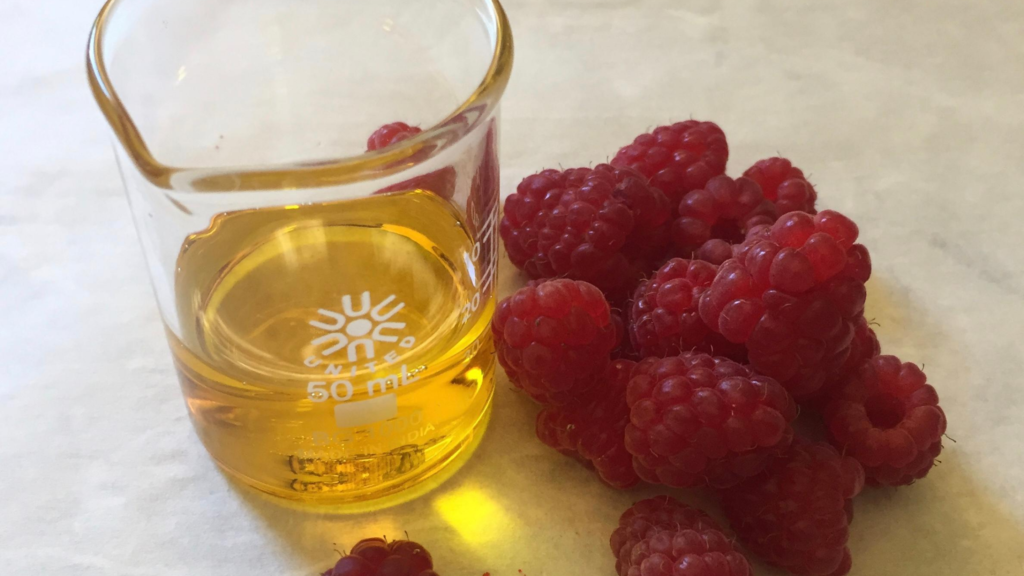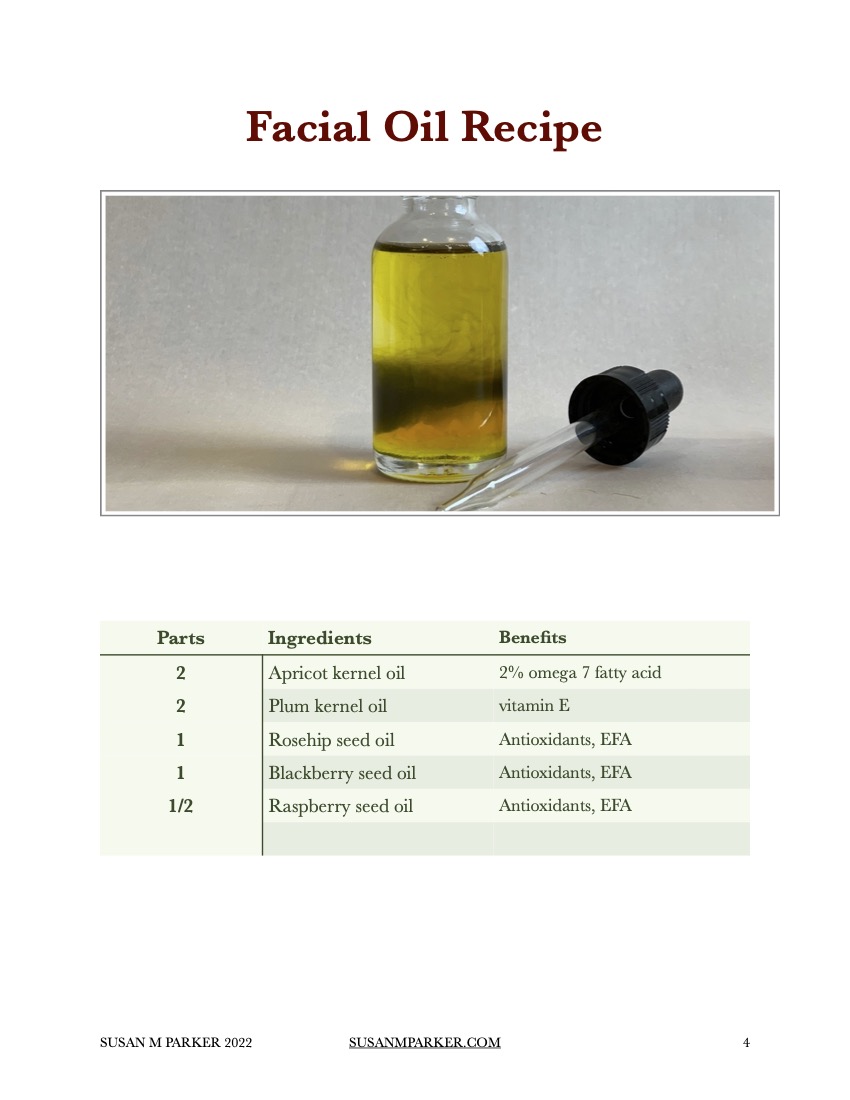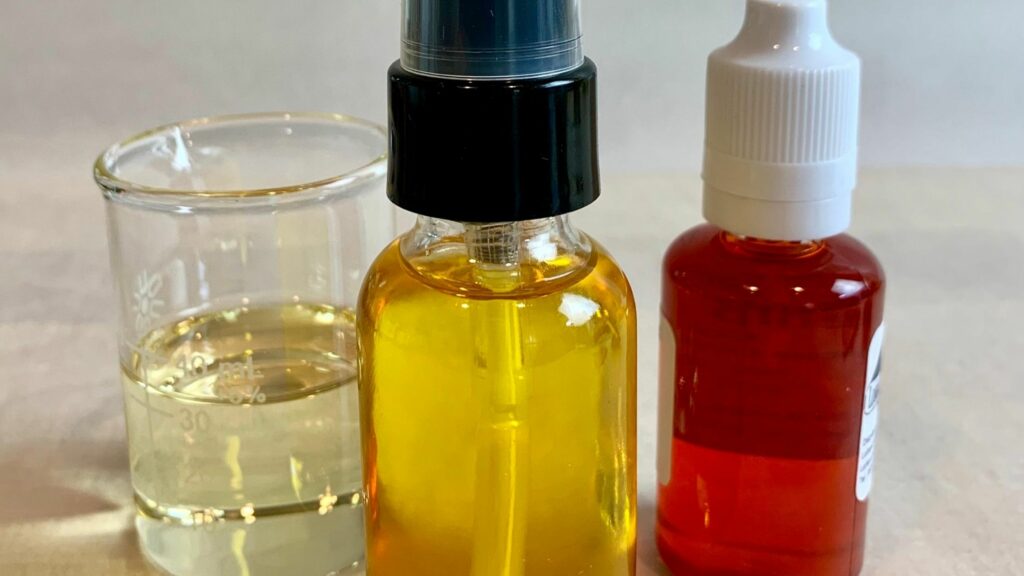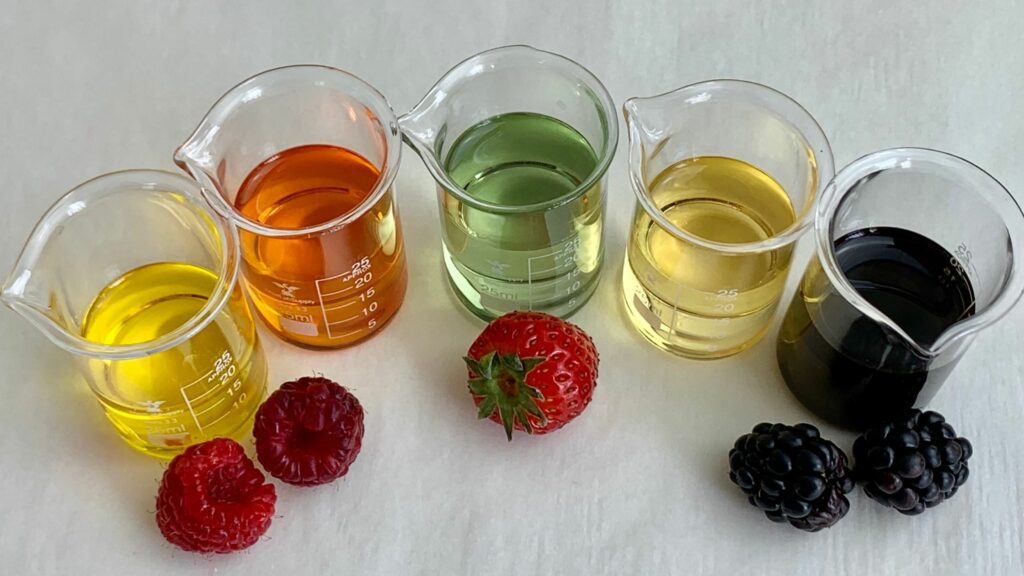The rose plant family has many oil-producing plants in both tree and shrub form. In this one family, we find fruit trees like peaches, plums, and cherries, and shrubs like raspberries and blackberries.
I added a list of some of the rose family oils at the end of this post.
What is interesting is that the oils fall into two distinct groups.
The oils from the stone fruits that are high in Oleic acid, tend to be pale in color and make good base oils.
Then we have the berry and shrub oils that are high in Linoleic and alpha-Linolenic acid, the two essential fatty acids. These tend to be more deeply pigmented and often rich in antioxidants and other plant compounds if not overly refined.

So for this facial oil, I selected a base of apricot kernel oils and plum kernel oil and then added some rosehip seed oil along with raspberry seed oil and blackberry seed oil.
Rose Facial Oil Recipe
The recipe below is in parts.
2 parts apricot kernel oil
2 parts plum oil
1 part rosehip seed oil
1 part blackberry seed oil
1/2 parts raspberry seed oil

Get a copy of the recipe card and a list of oils from the rose family.
Variations and Substitutions
Both apricot kernel oil and plum seed oil are high in monounsaturated fatty acid oleic acid. They tend to be minimally pigmented with mild to no scent.
You could substitute peach kernel oil or almond oil for either of the two here.
The rosehip seed oil contributes the two essential fatty acids and if an unrefined version a good dose of antioxidant carotenoid pro-vitamin A.
The berry oils, in this recipe blackberry and raspberry seed oils are both high in the two essential fatty acids, linoleic acid, and alpha-linolenic acid.
They are also both, rich sources of anti-oxidants.
A note on rosehip seed oil and pigment
I’ve seen rosehip seed oils that are bright red in color and others that are quite pale. The lipid oils can vary quite a bit depending on the method and amount of refining involved!
If you have a highly pigmented rosehip seed oil, you can dilute it with almond oil or another neutral oil from the rose family.
I’ve found a 1:6 ratio works well. You still get the skin-nourishing benefits of the rosehip seed oil without creating a combination that might turn your skin temporarily orange!
In this recipe, we find a nice balance of skin-nourishing base oils.

Lipid Oils from the Rose Family
From this one family we have:
- Plum kernel oil
- Peach kernel oil
- Almond oil
- Apricot kernel oil
- Rose hip seed oil
- Raspberry seed oil
- Blackberry seed oil
- Quince seed oil
- Apple seed oil
- Cherry kernel oil
- Strawberry seed oil
- Cloud berry seed oil
- Pear seed oil
Pear and apple seed oil are still relatively new to the market, and as time progresses I anticipate we will see more unique oils from this family! Here’s a video on some of the different rose family oils.
Have you worked with any of these rose family lipids recently? Share in the comments below.


Could you suggest a good reputable place to get some of these wonderful oils? I have a lot of oils. I started becoming intrigued by oils and wanted to dive deeper into oils and knowledge someone in a group on FB suggested your book The Power of the Seed and I bought it. Thank you for writing the book I’m so intrigued by all the knowledge. I do have a license in Skincare/Cosmetology but this is opening a whole new door. I just wanted to say Thank you for sharing all your studies and knowledge.
If you are in the Lipid Love Facebook group go to the files section and there is a Sources document you can use to find good sources.
Hey Susan, I don’t have Facebook anymore, if you could send suggestions of a few businesses, I would appreciate it as well.
Please what do you mean by parts in your formula? Can you break it down to percentage?
So the recipe in percentages is 31% each for the Apricot and plum, 15% each for the rosehip and blackberry, and 8% raspberry.
I use Rose hip seed oil a lot in my face serums and face creams. I like to use Sweet Almond oil and Apricot kernel oil in lip and body balms. I wanted to try raspberry, but it is a little more expensive.
oils excite me so much! Wow Cloud oil??? Quince seed?? never heard of these….amazing
I love working with Pear, Blackberry ,& Rosehip seed, and Apricot Kernel oils.
Where can I purchase the plum and berry oils? I’ve looked at both MRH and Rosemary’s Garden to no avail.
Lotioncrafter.com
Have you tried Making Cosmetics or ingredients to die for?
can i get beautiful blue color after infusing blueberry dried into carrier oil ?
thank you
Most oils are slightly yellow so a blue colors going to be hard to achieve – they will turn out more green than blue. But you could experiment with the clearest oils and let us know. Good luck
thank you so much 🙂
Have you ever infused indigo powder in oil?
Hi Amy, No, haven’t tried indigo powder in oil – experiment would be my suggestion. If you are looking for the color you might need to do more than just infuse. Doesn’t the color develop after a period of soaking then exposing to light? Anyway have fun
I just finished your oils class and it was so GREAT 🙂 Thank you.
As for the Indigo…it is hard to find information on the uses. There are a few studies that say it’s good for rash skin. I did infuse some organic indigo powder in oil and I think it’s just such a fine particulate the oil is now blue. As a natural dyer working with fiber the process is: A very alkaline water vat has had all excess oxygen removed so the indigo molecule can bond with the water molecule and it then reduces and becomes yellowish As you dip and then remove your fiber back into the oxygen the indigotin turns blue again. You do this over and over for depth of shade. I will let you know how my oil feels on the skin and if it’s just too messy to deal with! I can’t wait to take another class with you!
oh my….looks delicious… I love working with the lipids…so much. will try this one
My Dream is to make my own perfume body all purpose oil that’s also healing to the skin, I work with essential oil but this is good I’m definitely going to order..Thank you
This sounds beautiful. My plum kernel oil has a very potent smell. Marzipan like. Is that your experience as well?
Yes, a few of those can be very highly scented with the marzipan scent. It is often refined out so scent will vary.
Thank you, Susan. This was timely, as I’m making a new batch of face serum this afternoon, and will use these oils instead of my usual oils. I’m missing blackberry, but it looks so lovely in the photo that I’m ordering it today. I appreciate your generosity in sharing your knowledge.
i love rose hip for my facial lotion – great for aging skin. use it often. haven’t tried the berry oils yet
Do these oils have Rose fragrance too?was wondering if Carrier oils can add Fragrance and Color too?
The rose fragrance is obtained from the flower petals, so no the seed oils do not have a rosy scent.
Thank you so much for this. You are amazing sharing your valuable knowledge, such a wonderful person! 😀
I have worked and love rose hip seed oil.
Didn’t know they all came under the rose family
I love the way the blackberry seed is suspended there…. just waiting… I have your Power of The Seed on the shelf infront of me…so glad you wrote it. It’s well thumbed with oil stains 🙂